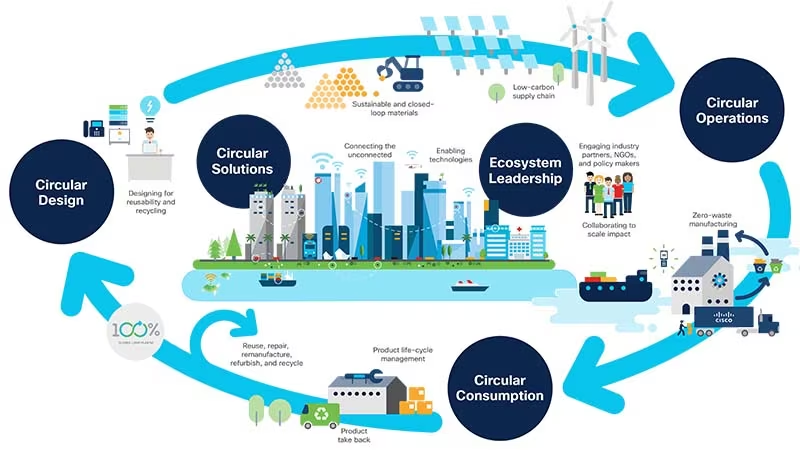The Circular Economy and Supply Chains
The circular economy is an economic model that aims to eliminate waste and promote the continual use of resources. In a circular economy, products and materials are reused, repaired, and recycled instead of being discarded as waste. This can be achieved through designing products for reuse and recycling, implementing sustainable production processes, and establishing closed-loop supply chains.
In a circular economy, supply chains are essential, as they can help ensure that products and materials are reused and recycled at the end of their useful life. Companies can reduce waste, save resources, and minimize environmental impacts by implementing circular supply chains.
Circular supply chains involve a range of strategies, such as:
- Designing products for reuse and recycling: By designing products with a focus on recyclability and durability, companies can help to ensure that materials are reused and waste is minimized.
- Implementing closed-loop supply chains: Closed-loop supply chains involve capturing and reusing materials at the end of their useful life. This can include recycling, refurbishing, and remanufacturing.
- Adopting sustainable production processes: By using renewable energy sources, reducing water consumption, and minimizing waste, companies can reduce the environmental impact of their production processes.
- Collaborating with suppliers and customers: Companies can work with suppliers and customers to implement circular supply chains, by sharing information, resources, and best practices.
The benefits of circular supply chains include reduced waste, increased resource efficiency, and improved environmental performance. In addition, circular supply chains can create new business opportunities, such as remanufacturing and recycling services. Companies can contribute to the transition to a more sustainable and resilient economy by adopting circular supply chain strategies.

Contrast between Conventional and Circular Supply Chain
Conventional supply chains are linear in nature, meaning that resources are extracted, used to produce goods, and then discarded as waste. This results in a significant amount of waste and pollution, and places a strain on natural resources. In contrast, circular supply chains are designed to promote the continual use of resources, by reusing and recycling materials at the end of their useful life.
The main differences between conventional and circular supply chains are:
- Resource usage: In conventional supply chains, resources are used in a linear manner, and waste is generated at every stage. In circular supply chains, resources are reused and recycled, reducing waste and promoting resource efficiency.
- Product design: In conventional supply chains, products are often designed with a focus on maximizing sales and profits, with little consideration for their end-of-life disposal. In circular supply chains, products are designed with a focus on reuse and recycling, and are often more durable and easily recyclable.
- Supply chain management: Conventional supply chains are often managed in a fragmented manner, with little coordination between different stages of the supply chain. In circular supply chains, there is a greater focus on collaboration and coordination, with a view to maximizing resource efficiency and minimizing waste.
- Environmental impact: Conventional supply chains have a significant environmental impact, due to their linear nature and high levels of waste and pollution. In circular supply chains, the environmental impact is minimized, as resources are reused and recycled, reducing the need for new resources to be extracted.
Overall, circular supply chains offer a more sustainable and resilient approach to supply chain management, by promoting resource efficiency and reducing waste and pollution. By adopting circular supply chain strategies, companies can contribute to a more sustainable and resilient economy, while also improving their environmental performance and reducing costs.
Environmental Viscous Circle of Logistics
The environmental vicious circle of logistics refers to the negative impacts that logistics activities can have on the environment, which in turn can lead to further negative impacts on logistics operations. The main aspects of the environmental vicious circle of logistics include:
- Emissions and pollution: Logistics operations generate a significant amount of greenhouse gas emissions and air pollution, which can contribute to climate change and harm human health. In turn, these impacts can lead to disruptions in supply chain operations, as well as increased costs for logistics providers.
- Resource depletion: Logistics activities can also contribute to the depletion of natural resources, including energy and water. As these resources become scarcer, the cost of logistics operations can increase, which can lead to further environmental impacts as companies seek to cut costs through more resource-intensive practices.
- Waste generation: Logistics operations generate a significant amount of waste, including packaging materials, discarded products, and food waste. This waste can contribute to pollution, greenhouse gas emissions, and resource depletion, leading to further negative impacts on the environment.
- Environmental regulations: As governments around the world introduce more stringent environmental regulations, logistics providers may face increasing costs and regulatory risks, further contributing to the environmental vicious circle of logistics.
Breaking the environmental vicious circle of logistics requires a concerted effort from logistics providers, policymakers, and other stakeholders to adopt more sustainable and environmentally-friendly practices. This can include measures such as optimizing transport routes, using more fuel-efficient vehicles, reducing packaging waste, and adopting circular economy approaches to logistics operations. By taking a proactive approach to environmental sustainability, logistics providers can help to break the vicious circle and contribute to a more sustainable and resilient economy.

